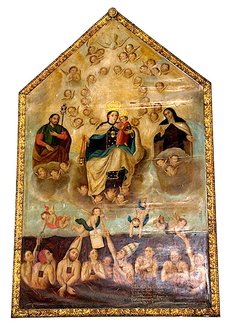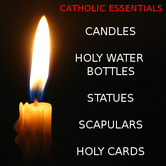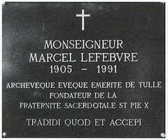
Presenting the Scapular to Saint Simon for the world, Our Lady makes but one condition to Her promise of Salvation: "Whosoever dies clothed in this Habit shall not suffer the fires of hell". She promises that anyone who enters Her family of Carmel, and dies there, shall not be lost.
Seven centuries have passed over that promise and its exact meaning, which is anything but obscure, seems to have troubled hundreds of speakers and writers almost to the point of obsession. "Satan perceived what a great multitude of souls the Scapular was going to snatch from him," remarks a modern writer. "He groaned with rage and swore to avenge himself of this recent, other most terrible blow that the Immaculate had just given him. In his fury he declared war to the death on this sacred Habit, especially attacking the unusual privilege with which it is endowed, and hence one soon saw arising from all parts, even from the bosom of the Church, a cloud of specious objections against the remarkable promise attached to Mary's Scapular. Some denied its existence; others saw in it a direct contradiction to the divine teaching; it was combatted, mal-interpreted, and even denatured." So probably the first thing we will ask ourselves on hearing Mary's remarkable words is: "What did Our Lady mean?" First, Mary does not mean by Her promise that anyone dying even in mortal sin will be saved. Death in mortal sin and damnation are one and the same thing. Mary's promise naturally rewords itself: "Whosoever dies clothed in this Habit shall not die in mortal sin." To make this clear, the Church often inserts the word "piously" into the promise: Quicumque in hoc "pie" moriens, aeternum non patietur incendium, i.e., "Whosoever is clothed in this, dying piously shall not suffer eternal fires."
Catholic theologians and authorities like Vermeersch, Saint Robert Bellarmine, Beringer, Benedict XIV, etc., explain the promise to mean that anyone dying in Mary's family will receive from Her, at the hour of death, either the grace of perseverance in the state of grace or the grace of final contrition.
To die in the membership of Mary's family is the one condition. Now, in order to so die, having been validly enrolled in the Confraternity by a Carmelite or a duly authorized priest, one must die clothed in the sign of membership. This Sign of membership may be the large Scapular of the religious Habit, the small Scapular, or the Scapular Medal; all have been recognized by the Sovereign Pontiffs as valid signs of that membership which the Mother of God rewards by an absolute assurance of final contrition and perseverance.
Hence the main requisite is valid enrollment. One must voluntarily join Mary's great confraternity through the hands of an authorized priest. A priest obtains his faculties from the Carmelite Order or from the Holy See. When he enrolls anyone, unless he has the special privilege of enrolling without the obligation of inscribing the names, he must see that the name of the one whom he enrolls is duly inscribed in the confraternity register. If he does not, the one invested is deprived of many benefits of the Scapular. There are a few instances when the names need not be entered on the register. Missionaries have the power, at times, to enroll many people at one time by the recitation of one single formula. In this case, technically known as magnus concursus fidelium, those enrolled are really members of the Confraternity without the inscription of the names because the Holy See has so willed. Pope Pius X granted to soldiers at war the unusual privilege of enrolling themselves. In such a case, however, the Scapular, or Scapular medal, must have been previously blessed and, while clothing himself, the soldier must recite some prayer to the Blessed Virgin, be it only three Hail Marys.
Many have not understood Mary's Promise exactly. On hearing the importance of enrollment and inscription of names, a doubt arises in their minds as to whether they may have been validly invested. Due to the bounty of the Popes, however, there need be no such worry. Pius X, on January the twentieth, 1914, officially validated, with his Sovereign power, the admission of any of the faithful into the Confraternity that had been invalid for any cause whatsoever. Pius XI renewed that validation in 1924, 1928 and 1939. Anyone enrolled before April, 1939, is therefore sure that he is a member of Mary's family.
As the reader will understand more fully later, the whole meaning of the Scapular Promise derives from the fact that the wearing of the Scapular is a true devotion to Mary. Hence, that the Scapular-wearer have his name on the confraternity register is not enough to obtain the benefits of the Scapular. True devotion to Mary always has three notes: homage, confidence and love; and to be a sign of Salvation those three notes must be practiced perseveringly. When we invest ourselves in the Scapular we practice the homage of becoming members of the Queen's battalion, we profess confidence in Her promises, and we become Her special children of love. But in order to be assured of Salvation, we must persevere in those sentiments and it is only by wearing the Sign of membership until death that we can continually show the Mother of God that we venerate Her, believe in Her, and love Her. Hence it is not enough to be a member of Mary's family; we must profess our membership. Only he is sure of Mary's great promise who has validly entered the Society gathered 'neath Her mantle and dies actually clothed in the Sign of that membership.
Much discussion has arisen in recent years as to just what is validly a Sign of Membership in the Carmelite Confraternity. There are undoubtedly three valid signs; but just how must they be worn and when may one or the other be worn?
The large habit of the Carmelite Order offers no difficulty.
The small habit, known commonly as the "Brown Scapular," is likewise clearly defined. It differs from the large habit only in size. After he is enrolled, therefore, a member of the Confraternity can renew his own Scapular even as a religious, once invested, can make his own habit. It must, however, be like the large one. It must be of woven wool, of a color somewhere between brown and black (preferably brown, of course), and of rectangular shape. It must be so made that it can hang over the shoulders and thus rest at once against the front and back of the body. New Scapulars need not be blessed once the wearer has been enrolled; they derive their excellence from the fact that they are a Sign of that membership which Mary rewards with an assurance of Salvation; they become such a sign the moment that a duly enrolled member of the Confraternity assumes them.
to be continued.............................




